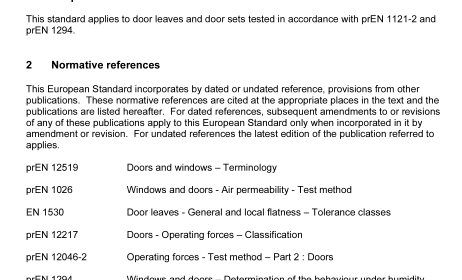BS EN 1989:2000 – Thermoplastics piping systems Ð Joints for buried non-pressure sewerage applications Ð Test method for long-term sealing performance of joints with thermoplastic elastomer (TPE) seals by estimating the sealing pressure

1 Scope
This standard specifies a method for determining the long-term sealing performance of joints with thermoplastic elastomers (TPE) seals for plastics piping systems for buried non-pressure sewerage. This method, which estimates the sealing pressure for the seal, is intended to be used only for joints with sealing rings located in a socket.
2 Normative references This Standard incorporates by dated or undated reference, provisions from other publications. These normative references are cited at the appropriate places in the text and the publications are listed hereafter. For dated references, subsequent amendments to or revisions of any of these publications apply to this Standard only when incorporated in it by amendment or revision. For undated references the latest edition of the publication referred to applies. ISO 471 , Rubber — Temperatures, humidities and times for conditioning and testing
3 Principle
The radial specific sealing force, F S , and sealing width, S W , of a TPE seal are measured with the seal located in an applicable socket. Both these parameters are measured at increasing time intervals within a period of time of at least 2200 h. The regression lines for F S and S W are used to calculate the sealing pressure, P S , at 90 days. The extrapolated regression lines for F S and S W are used to calculate the estimated value of P S at 1 00 years (see clause 8). NOTE It is assumed
that the following test parameters are set by the standard making reference to this standard: a) the number of sample pairs and the sampling procedure (see 5.1 and 5.3); b) if applicable, any change to the limit(s) between the time of production of the seal and the start up of testing (see 6.1 ).
4 Apparatus
4.1 A device, capable of measuring the specific radial sealing force exerted by a seal onto a mandrel. The apparatus consists of a steel cylinder, the mandrel, of which a segment can compress the seal in the radial direction (see 7.2.2).
The surface width, C, of the segment (see Figure 1 ) shall have a value lying between 5 % and 1 0 % of the circumference of the mandrel. The segment is linked to an instrument capable of measuring the compression forces with an accuracy to within ± 5 % of the measured value, and with a means of measuring displacements greater than 1 0 micrometres (1 0 µm) with an accuracy of ± 1 µm. A typical arrangement of the mandrel and segment is shown in Figure 1 . The mandrel shall have the minimum specified outside diameter of the pipe or spigot (tolerance: which the socket is intended.
BS EN 1989:2000 – Thermoplastics piping systems Ð Joints for buried non-pressure sewerage applications Ð Test method for long-term sealing performance of joints with thermoplastic elastomer (TPE) seals by estimating the sealing pressure